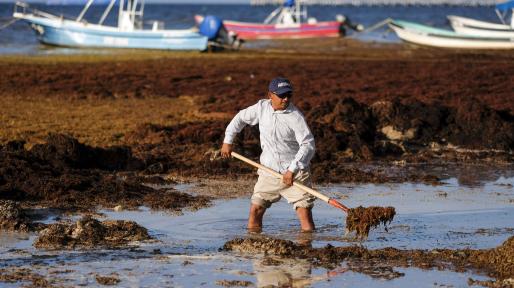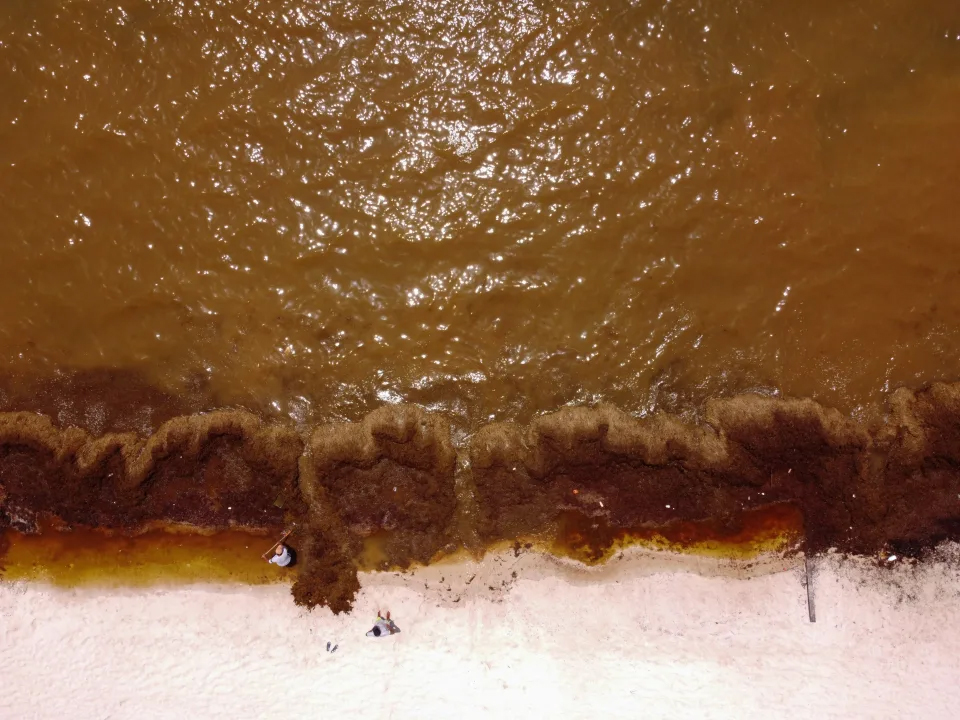Seaweed Blob Threatens Florida as
Residents Report Health Issues
As a giant seaweed blob, twice the size of the United States, approaches Florida, concerns continue to mount. Floridians along the state’s southwest coast have already reported experiencing burning eyes and breathing difficulties, adding to the urgency of the situation.
The seaweed’s arrival highlights the critical need for further investigation into the potential causes of this phenomenon and the impact it could have on local communities. Scientists are working to understand the factors contributing to the massive seaweed bloom and what can be done to mitigate its effects.
The colossal seaweed bloom, visible from outer space, is reportedly making its way towards Florida’s Gulf Coast.
The colossal seaweed bloom, visible from outer space, is reportedly making its way towards Florida’s Gulf Coast. The sargassum bloom, which spans an incredible 5,000 miles, is twice the width of the United States and is believed to be the largest of its kind in history.
Scientists are closely monitoring the situation, concerned about the potential impact on local ecosystems and communities. The sheer size of the seaweed bloom underscores the urgent need for greater research and understanding of our oceans and natural ecosystems.

As the bloom approaches Florida, residents and officials are advised to remain vigilant and take necessary precautions. The arrival of the sargassum bloom highlights the importance of continued efforts to protect our environment and the delicate balance of our planet’s ecosystems.
The massive seaweed bloom, which spans an area twice the width of the United States, is currently drifting between the Atlantic coast of Africa and the Gulf of Mexico. Despite concerns over its potential impact, the thick mat of algae has the ability to provide a vital habitat for marine life and absorb carbon dioxide from the atmosphere.
Potential Negative Effects of Seaweed
Bloom as it Approaches Shore
While the massive seaweed bloom drifting between the Atlantic coast of Africa and the Gulf of Mexico can provide potential benefits, it can also have devastating consequences as it nears the shore.
The thick mat of seaweed can deprive coral of sunlight, potentially causing irreparable harm to local ecosystems. Additionally, as the seaweed decomposes, it can release hydrogen sulfide, negatively impacting the air and water quality and causing respiratory problems for nearby residents.

As the seaweed bloom approaches Florida’s Gulf Coast, concerns are mounting over the potential negative effects it could have on local communities and ecosystems.
Brian LaPointe, a research professor at Florida Atlantic University’s Harbor Branch Oceanographic Institute, expressed concern about the potential impact of the approaching seaweed bloom, stating, “What we’re seeing in the satellite imagery does not bode well for a clean beach year,” according to NBC News.
“What we’re seeing in the satellite imagery does not bode well for a clean beach year,” according to NBC News.
Brian Barnes, an assistant research professor at the University of South Florida’s College of Marine Science, warned that the seaweed could still pose a threat to critical infrastructure if it remains in coastal waters. “It can block intake valves for things like power plants or desalination plants. Marinas can get completely inundated and boats can’t navigate through,” Barnes said.
The impending seaweed bloom is causing further anxiety for Floridians along the state’s southwest coast, who have already been dealing with health issues and dead fish washing up on beaches. The current bloom started in October and comes as the region experienced a recent flare-up of toxic red tide algae.
As the seaweed approaches the coast, the potential consequences of its presence are becoming more apparent. The situation underscores the importance of responsible management of our natural resources and the need for ongoing research and monitoring of our oceans and their ecosystems.



